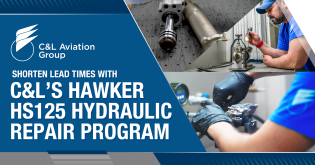
As an ATR operator, you understand the critical role de-ice boots play in keeping ice buildup off the wings while in flight. What you might not know, however, is what repairs – and how many – can be made to damaged de-ice boots, or what de-ice boot replacement options are available.
We support ATR 42/72 aircraft and have years of experience assisting operators with their de-ice boots. Here, we address common concerns ATR operators have about de-ice boot repair and replacement, providing you with an understanding of:
- What de-ice boot repairs can be done in-house
- The allowable limits for repairs before requiring a replacement
- Replacement options
- Replacement downtime
- De-ice boot costs
What are ATR De-Ice Boots?
A de-ice boot (or deicer or deicing boot) is a specialized ice protection system installed along the leading edges of aircraft wings and flight surfaces that mitigates ice buildup. The rubber de-ice boot is inflated via a pneumatic system. As the de-ice boot expands, it cracks and loosens any ice buildup along the leading edges. The ice then blows away into the airflow.
Allowable Limits for Repairing ATR De-Ice Boots
Regular Inspections and Damage Assessment
Inspecting the de-ice boots during regular line maintenance will reveal if the de-ice boot is damaged. Any damage to the de-ice boots, such as holes or cuts, will result in air leaks and decrease the boot’s effectiveness against ice buildup. Minor damage can be quickly repaired on wing using a patch or a patchless repair process provided the damage does not exceed the allowable limits.
Defining Allowable Limits
Allowable limits are defined by the number of patches or patchless repairs acceptable within a 19.68-inch (0.5 m) linear area. The component maintenance manual (CMM) specifies the acceptable number of patches and patch sizes (replicated below). De-ice boot replacements are required if the damage – and number of patches – exceeds the allowable limits.
Patch and Patchless Repair Specifics
Patches cannot run perpendicular to the direction of the de-ice boot tube, and patches cannot be placed partially over another patch.
The patchless repair process is for small cracks less than ¼-inch in length and can be applied multiple times over the same area. No more than 25 repairs are allowed on a 39.37-inch (1 meter) tube section. This accounts for both the number of patches and patchless repairs. For instance, only 6 patches of varying sizes can accompany 19 patchless repairs.
Note: Always refer to the component maintenance manual (CMM) for information about your ATR de-ice boot and repairs.
ATR De-Ice Boot Replacement Options
Once repairs exceed the allowable limits, you will need to obtain a replacement. The following are the various options for acquiring a new de-ice boot:
- In-house installation
- Repair shop installation
- De-ice boot and leading-edge exchange
- De-ice boot and leading edge purchase
Choosing an option will depend on your needs, the associated costs, and possible time constraints.
De-Ice Boot In-House Installation
Installing a new de-ice boot in-house is a cost-effective solution in comparison to shipping the de-ice boot and leading edge to a shop for installation. However, this option may not be beneficial in time-sensitive situations. Installing a de-ice boot takes approximately one week – provided the installation is conducted correctly.
Incorrectly installed de-ice boots will work ineffectively and will need to be removed. De-ice boots damaged during installation cannot be re-applied. In these cases, a new de-ice boot must be purchased, thus increasing the overall cost and extending downtime.
This option is only recommended for operators with the capability and professionals to install the de-ice boot.
De-Ice Boot Repair Shop Installation
Alternatively, you can have a repair shop install the de-ice boot. A benefit to this option is that the shop can repair or overhaul the leading edge, if necessary, before installing the de-ice boot. Repair shop installation is moderately cost-effective, and the de-ice boot installation takes approximately a week.
Exchanging De-Ice Boot and Leading Edge Assembly
If you have time constraints, a quicker alternative would be to exchange your existing leading edge with an overhauled leading edge assembly with a new de-ice boot already installed. Exchanged ATR leading edge assemblies are regularly available on the market. Although a more costly option, exchange units can generally be delivered with 1 to 2 days.
Purchasing De-Ice Boot and Leading Edge Assembly
Another quick way to obtain a leading edge and de-ice boot assembly is to purchase an overhauled unit outright off the market and install it on your aircraft. Meanwhile, your “off” leading edge may be overhauled with a new de-ice boot installed, ready for future requirements. Note that this is likely the most expensive option.
How Much Do ATR De-Ice Boots Cost?
The price range for the ATR de-ice boot alone is between $2,000 and $10,000, with approximately $7,000 as the average cost. For the installation or obtaining an entire leading edge assembly, the price is between $4,000 and $30,000. The length of the boot is the biggest factor in determining the cost of the boot.
How Long Do ATR De-Ice Boots Last?
Once installed on an aircraft, the ATR de-ice boots have a life expectancy of anywhere from 6 months to 2 years.
How long your de-ice boots last depends on the operating environment, amount of use, and preventative maintenance. For instance, de-ice boots operating in coastal or desert regions will experience more erosion, and aircraft that commonly fly into known icing will use their de-ice boots more frequently, thus impacting the longevity of the de-ice boots.
When to Replace ATR De-Ice Boots?
Damage to the de-ice boot necessitates immediate repair or replacement, and the aircraft will be grounded until it has a functional de-ice boot. To help reduce inconveniences, consider replacing a worn de-ice boot early, coordinating its replacement with your aircraft’s next scheduled maintenance event.
Concluding Thoughts
The inspection, maintenance, and timely replacement of ATR de-ice boots are paramount for ensuring flight safety. By understanding the inspection process, allowable limits, and repair process, operators can make informed decisions about how to keep their ATR de-ice boots in optimal working condition.

















